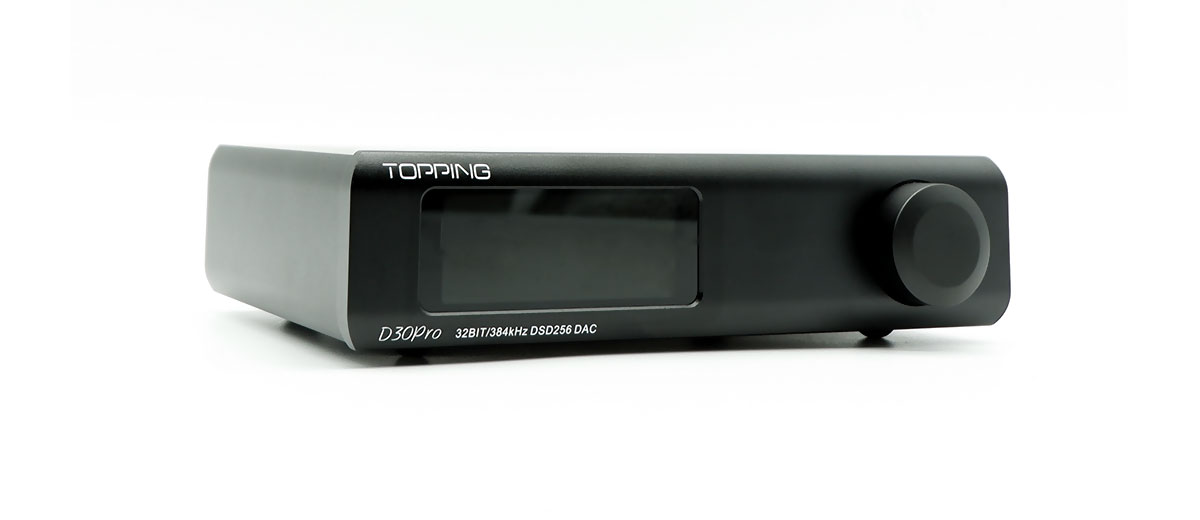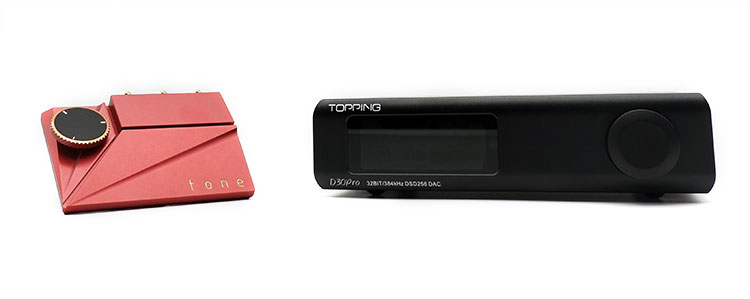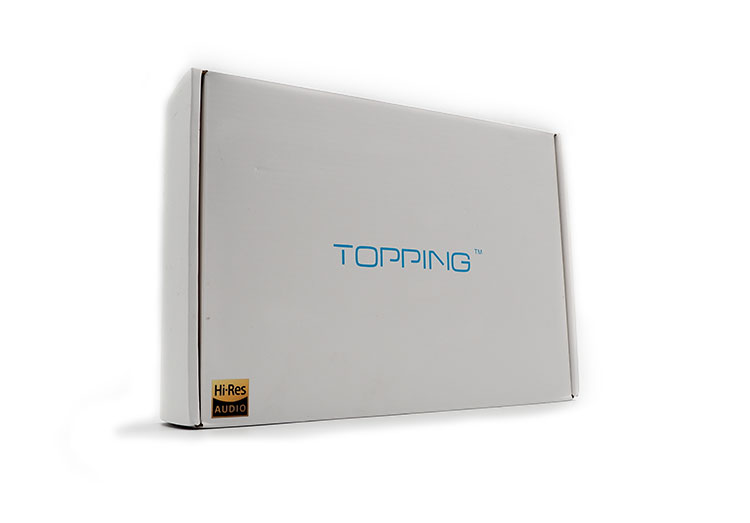Select Comparisons
Topping E30
Design
Coming from the same company, I can’t help but compare the E30 and the D30 Pro, despite the large price gap between the 2 devices. Physically, the E30 is less than half the size of the D30 Pro, but the E30 is a $129 device, so that’s pretty much expected.
However, the E30 requires an off-board power supply which is not included in the package, so adding in an off-board power supply will add a bit to the cost depending on which power supply you end up using. In my case, I ended up using iFi’s iPower 5V power supply for the E30.
Right in front, both the D30 Pro and the E30’s LCD screen look very similar. They both have an orange 7-segment display screen that displays either the volume level when in pre-amp mode, or the resolution being decoded when in DAC mode.
When it comes to accessing the interface, both devices actually work pretty much the same way. Where it involves turning off the device and holding a button to access the switch between DAC and Pre-amp mode. It’s just a bit more convenient with the D30 Pro since it has a physical power switch, while the E30 would need to be unplugged to access menu options.
Other menu options can also be accessed using the same remote control on both devices. The most obvious difference between the 2 devices though is that D30 Pro has a volume knob that can be pressed, while the E30 only has a single touch activated button.
The input options on both devices are similar, with both having an option for USB, coaxial or optical inputs. With the outputs, however, the D30 Pro has an additional balanced XLR output, as opposed to just a pair of single-ended outputs on the E30.
Technical
Both devices use the same USB controller, the XMOS XU208, and this is evident with the fact that when I first plugged in the D30 Pro, my computer identified it as the E30. I needed to reinstall the driver for the D30 Pro particularly before it was identified as the D30 Pro.
Downstream to the USB controller, the DAC chips that are used on the 2 devices are quite different. With the E30, Topping opted for the widely popular AKM AK4493 DAC chip, while the D30 Pro uses 4 pcs of Cirrus Logic’s CS43198 DAC.
Interestingly, the D30 Pro is only limited to PCM 32bit/384kHz, and DSD256, while the E30 can decode PCM up to 32bit/768kHz, and DSD512. While the E30’s decoding capabilities seem like it’s a notch higher than the D30 Pro, the resolutions that both DACs are capable of decoding are well above most of the widely available music in the market. So either device will do just fine in terms of decoding capabilities.
Performance
For most of my testing, I tested the D30 Pro using the 3-pin balanced XLR outputs, while the E30 was only running out of its single-ended RCA outputs.
Listening to the D30 Pro there is a clear step up when it comes to its ability to resolve more complicated passages. When listening to songs with complicated passages, like ones that have a drumline, a bass line, vocals, and some cymbal hits, the E30 tends to blur everything together, while the D30 Pro confidently keeps its composure, and presents each detail clearly and separately.
While both DACs try to keep tonality as flat as possible, the E30 is slightly thicker in the mid-bass region though, giving a more pronounced sense of impact. The D30 Pro on the other hand has a slightly drier, but more rounded sense of bass impact.
The vocal range is slightly more liquid with the E30, while the treble range is a touch more smoothed over when compared to the D30 Pro’s more honest presentation.
The soundstage on both DACs seems to be equally wide, while the E30 seems a bit more expansive. However, imaging is strikingly more accurate with the D30 Pro, where the images are more chiseled, while the directionality of the images is more defined. Also, there is a better sense of layering, within the soundstage with the D30 Pro.
While the decoding capability on the E30 might lead some to think that the E30 is better than the D30 Pro, those specs just mean that the E30 is more “future proof”. However, the D30 Pro is slightly drier but more honest with how it presents the music while having a more layered, and more fleshed-out soundscape.
SMSL SU-9
Design
The D30 Pro is slightly more compact, as the SU-9 has slightly more depth. However, both devices are constructed with aluminum chassis, so they both feel equally premium.
Both devices also have a volume knob, that doubles as a push-button. While both DACs have screens, the D30 Pro only has an orange LED screen, the SU-9 is equipped with a colored TFT screen that can display a lot more information.
The TFT screen on the SU-9 provides a more intuitive way of accessing the different settings available on the DAC. While both devices have the same volume knob that doubles as a button, the navigation of the settings is a very different experience between the 2.
The SU-9’s volume knob can be used for full menu navigation while the DAC is in use, with the ability to change input options, volume, sound color, filters, and brightness. With the D30 Pro, the volume knob is used for volume control and input selection normally. So I believe that Topping could have made more use of the knob.
The rear of both devices also has a similar set of inputs and outputs. However, in addition to having USB, optical and coaxial inputs that are common to both devices, the SU-9 also has a Bluetooth aerial that receives Bluetooth 5.0 with aptX, aptX HD, LDAC, and UAT.
Both devices have the same output options though, with both having a pair of single-ended RCA outputs and a pair of 3-pin XLR outputs.
Both devices also use a standard IEC power cable, and both of them have an option to switch to standby mode when the volume knob is pressed. However, the D30 Pro also has a hard power switch at the back of the device, that can totally disconnect the DAC from the mains power.
Technical
There are a lot of differences between the 2 DACs, and it starts with the USB controller. The SU-9 has an XMOS XU216 USB controller, instead of the XU208 on the D30 Pro. The DAC chips that are on the 2 devices are also very different, where the SU-9 has an ESS ES9038Pro chip, while the D30 Pro utilizes the less common Cirrus Logic CS43198.
The XU216 USB controller in conjunction with the ES9038Pro DAC chip allows the SU-9 to decode MQA files, and decode PCM files at 32bit/768kHz, and support for up to DSD512. While the D30 Pro is limited to 32bit/384kHz PCM, and DSD256. However, there is more to decoding than just the limits of the resolution that the DAC can handle.
Performance
Tonality on the 2 DACs is pretty much flat, and none of the frequencies are emphasized. Starting from the bass, they both can reach down low into the sub-bass region. Going into the midbass, they have equal volume, however, the SU-9 is a bit more rounded, impactful, and rich, while the D30 Pro is slightly drier and more textured.
Vocal presentation on the D30 Pro is on the drier side of things, where it doesn’t infuse the music with any additional coloration. The SU-9 in contrast is a touch more colored, with a bit more harmonic richness in its presentation. The presentation of acoustic instruments are also a bit fuller with the SU-9.
Both DACs are not particularly bright, so it’s safe to say that both of them are safe choices for people who might be a bit more treble-sensitive. This is not to say that treble presentation is the same on both.
The D30 Pro is more controlled and crystalline, while the SU-9 has a slightly more liquid and smoother presentation. With a slightly more extended treble, there is a touch more air with the SU-9 though.
With that touch of airiness, the SU-9 has a more expansive feeling soundstage. However, sound elements are placed in a similar location for both. It’s just that the D30 Pro is a touch more layered, and images tend to have a more finite quality to them. When listening to orchestral tracks that showcase the dynamic range, the SU-9 tends to play more gently when needed though.
Between the 2 DACs, the D30 Pro is the more honest, and drier of the 2 while the SU-9 is a bit more colored.
Khadas Tone2 Pro
Design
The Tone2 Pro is a much smaller device when it’s compared to the D30 Pro since the Tone2 Pro is just the size of a credit card. This makes the Tone2 Pro more of a transportable device when compared to the D30 Pro.
Both devices sport an aluminum chassis, which is a smart choice for chassis material since it can double as a heat sink. The Tone2 Pro has a bit more going on on top of the device though since it’s so compact.
So things like the volume knob and status indicator are both located on top of the device, which is surprisingly comfortable to use particularly desktop setups where the device should be kept nearer.
Features
In terms of features, the 2 devices are actually pretty similar. Both of them are capable of USB inputs, and coaxial inputs, but the Tone2 Pro lacks an optical input. Outputs on both devices are actually the same, where they both have single-ended outputs, as well as an option for balanced outputs.
With the Tone2 Pro’s smaller form factor though, everything had to be shrunk down. The USB input on the Tone2 Pro uses a USB type C input, while the one of the D30 Pro uses a standard USB B.
Balanced outputs on the Tone2 Pro also require a customized balanced RCA to 3-pin XLR adaptor to make use of the Tone2 Pro’s balanced output capability, which is an extra $50, bringing the price of the Tone2 Pro up to a total of $250.
Aside from having balanced outputs, the Tone2 Pro also has both a single-ended and pentaconn balanced headphone output. While the D30 Pro is a plain DAC. So the comparison will just be about the DAC section of the Tone2 Pro against the D30 Pro.
Technical
Despite the deceptively small size of the Tone2 Pro, it’s packed with everything that can be expected in such a small device. The USB controller on the Tone2 Pro is the XMOS XU216, instead of the XU208 found on the D30 Pro. This allows the Tone2 Pro to do full MQA decoding, while the D30 Pro doesn’t have any MQA unfold features.
The DACs on the 2 devices are also quite different, with the Tone2 Pro running on an ESS ES9038Q2M, allowing it to decode PCM streams up to 32bit/768kHz, and DSD512. The D30 Pro which has 4x Cirrus Logic CS43198 DAC chips is only limited to PCM 32bit/384kHz, and DSD256.
Both devices are capable of decoding most available music files though, so the higher decoding capabilities are just a form of more “future-proofing”.
Performance
On first listen, I initially thought that the Tone2 Pro is a bit more enjoyable than the D30 Pro. However, upon further examination, the D30 Pro has quite a few attributes that justify its larger size and higher price tag.
Neither DAC specifically emphasize any particular frequency, which is good. The presentation on both devices is quite different though. Sub-bass is a bit more linear on the D30 Pro, where it reaches a bit lower than the Tone2 Pro.
The mid-bass on the Tone2 Pro is a bit more emphasized than the D30 Pro though. Where drum hits take on a more rounded, but less textured character on the Tone2 Pro. While the D30 Pro has a more impactful drum hit.
The midrange is a bit more euphonic on the Tone2 Pro as well. However, midrange textural nuances are easier to pick out with the D30 Pro’s more resolving character.
Treble is equally detailed, where both DACs have a textured treble presentation. Cymbal hits have a textured presentation, but the Tone2 Pro tends to have a slightly longer decay, allowing the cymbal hits to have more shimmer but ends up a bit messier in more complicated passages.
Staging
Soundstage is equally expansive on both devices, while instruments tend to play a bit more intimately with the Tone2 Pro. Imaging is also equally chiseled, with both devices creating a coherent center image with ease. Image directionality and layering are a touch more accurate with the D30 Pro because it has a more finite quality to the images that it creates.
With the limited available power on the Tone2 Pro, its main disadvantage is the lack of instantaneous power delivery. This is immediately noticeable when listening to orchestral recordings, where there are gentler passages and sudden crescendos in the music.
The Tone2 Pro gives an impression that the whole passage plays at almost the same volume the whole time, while the D30 Pro makes the volume differences a lot more distinct.
Our Verdict
The D30 Pro is Topping’s answer to midrange DACs that have balanced outputs. However, D30 Pro is simpler than most of its competition with the lack of Bluetooth connectivity, a slightly more difficult menu interface, and the lack of a full-colored screen.
Still, the lack of those embellishments allows the D30 Pro to slash a few dollars off its price tag which could be a good thing for those who don’t absolutely need those additional features.
My first impression of the D30 Pro is that it’s an E30 that grew up, and added a pair of balanced outputs. However, it’s not that simple. The D30 Pro is actually a full-fledged contender in the midrange DAC market and a great upgrade from the more budget-conscious E30.
The D30 Pro leans towards a neutral, and honest presentation while having a good amount of layering and image separation. This makes the D30 Pro a clear choice for anyone looking for a no-frills, and honest DAC with a midrange price point.
Topping D30 Pro Specifications
USB In
- PCM 44. 1 kHz-384kHz/16bit-32bit
- DSD DSD64-DSD256 (Native)、DSD64-DSD128 (Dop)
- COAX/OPT IN: PCM 44. 1 kHz-192kHz/16bit-24bit
- DSD DSD64(Dop)
- D30 pro Decoding parameters (USB In@96kHz)
Line Out RCA
- THD+N@A-wt: <0.0001%@1kHz
- THD@No-wt 45kBw: <0.0004%@20-20kHz
- SNR@A-wt: 127dB@1kHz
- Dynamic range@A-wt: 127dB @1kHz
- Frequency Response:20Hz-20kHz(+0.1dB)
- 20Hz-40kHz(+0.3dB)
- Output Voltage: 2Vrms@0dBFS
- Noise @A-wt: < 0.9uVrms
- Crosstalk: -116dB@1kHz
- Output Impedance: 20Ω
Line Out XLR
- THD+N@A-wt: <0.00009% @1kHz
- THD@No-wt 45kBw: <0.0004 % @20-20kHz
- SNR@A-wt: 132dB@1kHz
- Dynamic range@A-wt: 132dB@1kHz
- Frequency Response:20Hz-20kHz(+0.1dB)
- 20Hz-40kHz(+0.3dB)
- Output Voltage: 4Vrms@0dBFS
- Noise @A-wt: < 1.1uVrms
- Crosstalk: -145dB@1kHz
- Output Impedance: 40Ω









